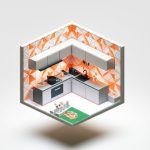Running out of space in your warehouse, office, or retail store? A two-tier mezzanine floor can drastically increase your usable area. This instructional guide provides a step-by-step approach to planning, designing, and building a safe and efficient two-tier mezzanine, covering material selection, structural requirements, and regulatory compliance to maximize your vertical real estate. For more information on mezzanine floors in general, see this helpful guide: Mezzanine floor guide.
Two-Tier Mezzanine Floor Design: Unlocking Vertical Space
Looking to significantly expand your workspace or storage capacity without expanding the building’s footprint? A well-designed two-tier mezzanine system offers a cost-effective solution. This guide provides actionable intelligence for successfully planning and implementing such a structure.
Why Choose a Two-Tier Mezzanine? The Advantages
There are compelling advantages to opting for a two-tier system:
- Significant Space Amplification: Essentially double or even triple your usable space by leveraging untapped vertical volume.
- Efficient Vertical Utilization: Transform otherwise unused overhead space into valuable functional areas, maximizing your existing footprint.
- Economical Expansion Alternative: Often proving more budget-friendly than horizontal expansions, especially in areas with high real estate prices.
- Adaptable and Versatile: Customize the mezzanine for various uses, whether it is storage, offices, manufacturing, or retail display.
- Improved Workflow: Separate operations by level, optimizing production, storage, or office layouts.
While it demands more meticulous planning compared to single-tier designs, the amplified space gains and efficiency justify the added upfront care.
Planning Your Two-Tier Mezzanine: A Detailed Approach
Careful planning is paramount before construction begins. Follow these steps to ensure a successful two-tier mezzanine project:
- Define the Purpose: Determine the intended use of each level (storage, office, production, retail display). This informs decisions about layout, load requirements, and access solutions.
- Conduct a Site Survey: Accurately measure the available space, noting ceiling height, floor load-bearing capacity, existing obstructions (pipes, electrical conduits), and soil conditions.
- Calculate Load Requirements: Determine the maximum weight each level must support, including static (stored materials) and dynamic (people, equipment) loads. Consult with a structural engineer to ensure safety and code compliance.
- Select Materials: Evaluate material options (steel, concrete, wood, aluminum) based on load capacity, cost, fire resistance, aesthetic appeal, and intended lifespan.
- Plan Access: Determine how people and materials will access each level (stairs, lifts, conveyors, ramps). Ensure accessibility complies with ADA standards (Americans with Disabilities Act) and local regulations.
- Ensure Regulatory Compliance: Research and adhere to local building codes and fire safety regulations. This includes obtaining necessary permits and approvals to avoid penalties and ensuring proper fire suppression systems are in place.
- Establish a Budget: Obtain multiple quotes from qualified contractors, factoring in materials, labor, permits, insurance, and contingency funds (typically 10-15% of the total project cost).
Design and Construction: Bringing Your Vision to Life
With careful planning steps completed, here’s how you can move into the design and construction phases.
- Create Detailed Blueprints: Develop precise blueprints and specifications in collaboration with a qualified structural engineer and architect. These should include detailed structural drawings, electrical layouts, and fire suppression system plans.
- Procure High-Quality Materials: Source top-grade materials from reputable suppliers, prioritizing durability, compliance with industry standards (e.g., ASTM standards for steel), and sustainability.
- Engage Professional Installers: Hire experienced and licensed contractors specializing in mezzanine construction for safe and code-compliant installation. Verify their insurance and bonding.
- Conduct Thorough Inspections: Perform comprehensive inspections during and after completion to verify structural integrity, regulatory compliance, and adherence to design specifications. This should include inspections by a structural engineer and local building inspectors.
Material Considerations: Weighing Your Options
Material choice dramatically impacts the load capacity, cost, and aesthetics of your two-tier mezzanine.
| Material | Pros | Cons | Typical Load Capacity (kN/m²) | Common Applications |
|---|---|---|---|---|
| Steel | Strong, versatile, long lifespan, fire-resistant, recyclable | Can be pricier, needs specialized installation, susceptible to corrosion if not treated | 4.8+ (Can Vary) | Warehouses, factories, heavy-duty storage, industrial platforms |
| Concrete | Durable, fire-resistant, sound dampening, high load capacity | Heavier, less adaptable, complex installation, longer curing time | 3.5+ (Can Vary) | Industrial storage, equipment platforms, areas requiring fire resistance |
| Wood | Often cheaper (initial cost), aesthetically pleasing, renewable | Less strong, susceptible to moisture damage, fire risk, requires regular maintenance | Varies greatly | Offices, retail spaces, light storage, residential applications |
| Aluminum | Lightweight, corrosion-resistant, recyclable | Lower load capacity compared to steel, more expensive than steel | 2.4+ (Can Vary) | Cleanrooms, food processing facilities, areas where corrosion is a concern |
| Bar Grating | Lets light through, relatively cheap, good ventilation | Lower load capacity, potential safety hazard (small items can fall through) | Lower | Walkways, platforms in areas requiring ventilation or light penetration |
Choosing the incorrect materials could cause severe structural problems. Factors to consider include the intended use of the mezzanine, the expected load, the building’s existing structure, and local building codes.
Ongoing Maintenance: Protecting Your Investment
Regular maintenance and inspections are vital for the long-term performance and safety of your mezzanine. Schedule inspections at least annually, and possibly more frequently based on usage and environmental factors, to proactively address potential issues before they escalate.
Maintenance Checklist:
- Structural Inspections: Check for signs of corrosion, bending, or damage to support beams, columns, and connections.
- Fastener Checks: Inspect and tighten bolts, screws, and other fasteners.
- Floor Surface Maintenance: Repair or replace damaged flooring to prevent trips and falls.
- Handrail and Guardrail Inspections: Ensure handrails and guardrails are secure and in good condition.
- Fire Safety Systems: Regularly inspect and test fire suppression systems, including sprinklers and fire extinguishers.
- Load Capacity Verification: Periodically re-evaluate load requirements to ensure they still align with the mezzanine’s capacity.
This comprehensive guide helps you design and construct a safe and effective two-tier mezzanine. Remember, the cornerstone to a structure that maximizes space and boosts efficiency is thorough planning, adherence to building codes, and regular maintenance.
How to Determine Maximum Safe Tiers for a Mezzanine Floor
Key Takeaways:
- Mezzanine construction necessitates strict adherence to building codes (primarily the International Building Code, or IBC, and OSHA (Occupational Safety and Health Administration) regulations).
- Safety and structural requirements are paramount. Balance extra space with adherence to safety standards.
- Compliance relies on area limits, headroom, egress (exit), load capacity, and materials. Plan carefully, and seek expert assistance.
- Local jurisdictions and code interpretations vary, mandating careful planning and expert input.
- Understanding the interplay between IBC and OSHA regulations is essential for safe and legal construction.
Navigating the Maze of Building Codes
Designing a multi-level mezzanine demands a solid grasp of complex building codes that ensure both structural integrity and worker safety.
The International Building Code (IBC), specifically Section 505.2 (or relevant local equivalents), outlines specific requirements for mezzanine structures. These requirements address area limitations, fire resistance, and means of egress. Never overlook OSHA regulations that strongly emphasize fall protection, safe access, and overall worker safety. Together, the IBC and OSHA ensure a compliant and safe design.
Consulting with a qualified code consultant familiar with local regulations is essential to navigate these complexities.
Calculating Load Capacity: The Foundation of Safety
Determining Maximum Safe Tiers for a Mezzanine Floor directly relates to calculating the load capacity. This is a precise engineering task, not guesswork. Consider the combined weight of the mezzanine structure, stored materials, equipment, and occupants.
Underestimating load capacity risks structural failure, and overestimating it wastes resources. A structural engineer is essential for accurate load calculations to determine if a two-tier design is feasible. “A qualified structural engineer is essential for accurate load calculations. They’ll determine whether a two-tier design is feasible on site,” leading structural engineers advise. The intended use also matters; light office space needs less support than heavy industrial storage.
Minimum load capacities might be specified by local building codes (e.g., 125 psf for storage, 60 psf for office space). An engineer provides detailed calculations based on the project’s specific requirements, including anticipated live loads, dead loads, and seismic loads.
Spatial Planning: Maximizing Space, Minimizing Risk
Careful spatial planning is required to enhance safety and prevent possible issues.
- Headroom: Maintain minimum clearances above and below the mezzanine for safety and comfort. A seven-foot minimum is common, but it may vary based on how the space is used and local building codes. Ensure adequate lighting
- Ceramic Tile Backsplash Ideas for Your Kitchen Remodel - December 21, 2025
- Contemporary Kitchen Backsplash Ideas for a Stylish Home - December 20, 2025
- Modern Kitchen Backsplash Ideas To Inspire Your Refresh - December 19, 2025










